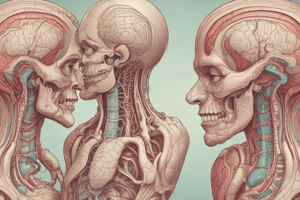Podcast
Questions and Answers
Which artery supplies blood to the sigmoid colon, rectum, and anus?
Which artery supplies blood to the sigmoid colon, rectum, and anus?
- Inferior vena cava
- Superior mesenteric artery
- Iliac artery
- Inferior mesenteric artery (correct)
Which primary germ layer gives rise to the connective tissue, including the muscular wall of the gastrointestinal tract?
Which primary germ layer gives rise to the connective tissue, including the muscular wall of the gastrointestinal tract?
- Mesoderm (correct)
- Ectoderm
- Endoderm
- Neural crest
In embryonic development, what does the endoderm differentiate into within the gastrointestinal tract?
In embryonic development, what does the endoderm differentiate into within the gastrointestinal tract?
- Smooth muscle
- Connective tissue
- Neurons of the enteric nervous system
- Epithelial lining (correct)
Which condition is characterized by the absence of ganglion cells in the distal colon, leading to symptoms like constipation?
Which condition is characterized by the absence of ganglion cells in the distal colon, leading to symptoms like constipation?
What role does understanding the large intestine's anatomy play in the diagnosis and treatment of gastrointestinal conditions?
What role does understanding the large intestine's anatomy play in the diagnosis and treatment of gastrointestinal conditions?
Flashcards
Large Intestine (Colon)
Large Intestine (Colon)
Final part of the GI tract; absorbs water/electrolytes, stores/eliminates waste.
Sections of the Large Intestine
Sections of the Large Intestine
Cecum, ascending, transverse, descending, sigmoid colon, rectum, and anus.
Functions of the Large Intestine
Functions of the Large Intestine
Water and electrolyte absorption, waste storage, supports beneficial bacteria for fermentation.
Blood Supply to Large Intestine
Blood Supply to Large Intestine
Signup and view all the flashcards
Development of Large Intestine
Development of Large Intestine
Signup and view all the flashcards
Study Notes
Large Intestine Anatomy
The large intestine, also known as the colon, is the final portion of the gastrointestinal tract, responsible for the absorption of water and electrolytes, as well as the storage and elimination of waste products. This article will provide an overview of the large intestine's anatomy and its role in the digestive system.
Structure of the Large Intestine
The large intestine is divided into four sections: the cecum, colon, rectum, and anus. The cecum, the first section, is a pouch that connects the ileum (the last portion of the small intestine) to the colon. The colon is further divided into the ascending colon, transverse colon, descending colon, and sigmoid colon. The rectum is a short, muscular tube that connects the colon to the anus, which is the external opening through which feces are expelled.
Functions of the Large Intestine
The primary function of the large intestine is the absorption of water and electrolytes from the chyme (the partially digested food) that is passed through it. The large intestine also serves as a reservoir for the storage of fecal matter, allowing for the regulation of bowel movements. Additionally, the large intestine is home to beneficial bacteria that help in the fermentation of undigested carbohydrates, producing short-chain fatty acids (SCFAs) that are essential for the health of the colon's mucosal lining.
Blood Supply
The large intestine is supplied by the inferior mesenteric artery, which branches off the aorta and provides blood to the sigmoid colon, rectum, and anus. The superior mesenteric artery, which branches off the aorta at a higher level, supplies the proximal portions of the colon, including the cecum, ascending colon, and transverse colon.
Development
During embryonic development, the gastrointestinal tract is formed by the fusion of the three primary germ layers: endoderm, mesoderm, and ectoderm. The endoderm gives rise to the epithelial lining of the gastrointestinal tract, including the large intestine, liver, gallbladder, and pancreas. The mesoderm gives rise to the connective tissue, including the muscular wall of the gut tube and the smooth muscle. The ectoderm further differentiates into the surface ectoderm, neural tube, and neural crest. The surface ectoderm is the precursor to the epidermis, lens of eyes, nails, hair, while the neural tube differentiates into the brain and spinal cord, and the neural crest is the source of the peripheral nervous system, including the neurons of the GI tract (also called the enteric nervous system).
Clinical Implications
Understanding the anatomy of the large intestine is crucial for the diagnosis and treatment of various conditions that affect the gastrointestinal system. For example, understanding the location and function of the different sections of the colon can help in the detection and management of colon cancer, a condition that often involves polyps (abnormal growths) in the colon. Additionally, the presence of a condition called Hirschsprung's disease, which is characterized by the absence of ganglion cells in the distal colon, can lead to constipation and other symptoms.
In conclusion, the large intestine plays a vital role in the digestive system, with its anatomy and functions being crucial for the absorption of water and electrolytes, the storage of waste products, and the maintenance of overall gut health. Understanding the anatomy of the large intestine is essential for the diagnosis and treatment of various gastrointestinal conditions and can help in the prevention and management of diseases that affect the colon.
Studying That Suits You
Use AI to generate personalized quizzes and flashcards to suit your learning preferences.




